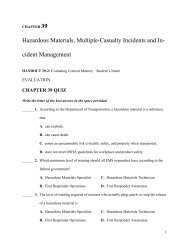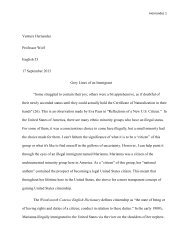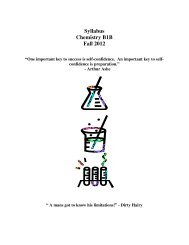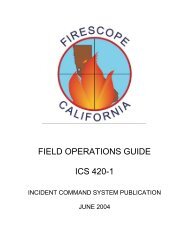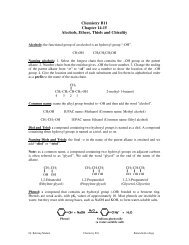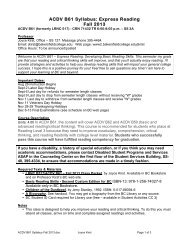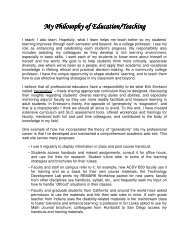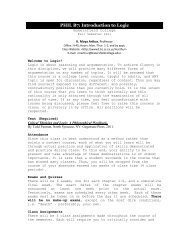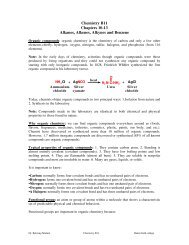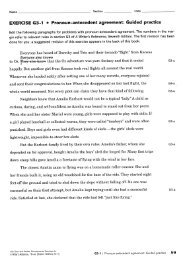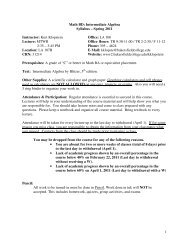The Well-Being of the EMT - Bakersfield College
The Well-Being of the EMT - Bakersfield College
The Well-Being of the EMT - Bakersfield College
Create successful ePaper yourself
Turn your PDF publications into a flip-book with our unique Google optimized e-Paper software.
CHAPTER 2<strong>The</strong> <strong>Well</strong>-<strong>Being</strong> <strong>of</strong> <strong>the</strong> <strong>EMT</strong>HANDOUT 2-2: Evaluating Content MasteryStudent’s NameEVALUATIONCHAPTER 2 QUIZWrite <strong>the</strong> letter <strong>of</strong> <strong>the</strong> best answer in <strong>the</strong> space provided.______ 1. It is important that an <strong>EMT</strong> takes care <strong>of</strong> his/her own health and well -being by focusing on:A. getting any work-related injury treated.B. double gloving on every call.C. prevention and wellness.D. showering after every shift.______ 2. Organisms that cause infection, such as viruses and bacteria, are:A. toxins. C. venoms.B. pathogens. D. poisons.______ 3. Equipment and procedures that protect you from <strong>the</strong> blood and bodyfluids <strong>of</strong> <strong>the</strong> patient are referred to as:A. infective body fluid measures.B. isolated infection controls.C. preventive control substance standards.D. Standard Precautions.1
______ 4. Gloves, masks, and gowns are examples <strong>of</strong>:A. HEPA. C. PPE.B. CDC. D. OSHA.______ 5. <strong>The</strong> positive form <strong>of</strong> stress that helps people work under pressure andrespond effectively is:A. distress. C. eustress.B. anxiety. D. residual tension.______ 6. A highly contagious viral respiratory disease which frequently mutatesinto new forms is called:A. hepatitis C. AIDSB. influenza D. MRSA______ 7. <strong>The</strong> goal <strong>of</strong> <strong>the</strong> Critical Incident Stress Debriefing is to:A. assign blame for <strong>the</strong> incident.B. assist patients to recover.C. assist emergency care workers in dealing with stress.D. allocate funds for ambulance services.______ 8. <strong>The</strong> first stage <strong>of</strong> stress is also known as:A. Alarm reactionB. ResistanceC. ExhaustionD. Surprise______ 9. <strong>The</strong> stage <strong>of</strong> grieving in which a patient seeks to postpone death, even2
for a short time, is:A. anger. C. acceptance.B. bargaining. D. denial.______10. It is important that <strong>the</strong> <strong>EMT</strong> follow <strong>the</strong> same path in and out <strong>of</strong> a crimescene in order to:A. expedite patient care.B. assist <strong>the</strong> police <strong>of</strong>ficer in scene control.C. prevent disturbing <strong>the</strong> crime scene.D. thoroughly document <strong>the</strong> location <strong>of</strong> <strong>the</strong> crime.______ 11. <strong>The</strong> agency that has issued strict guidelines detailing precautions againstexposure to blood-borne pathogens is <strong>the</strong>:A. American Red Cross Corporation.B. Centers for Disease Control and Prevention.C. Occupational Safety and Health Administration.D. Citizens for a Progressive America.______ 12. Which <strong>of</strong> <strong>the</strong> following materials is NOT recommended for gloves tobe used when <strong>the</strong>re is <strong>the</strong> potential for contact with blood and o<strong>the</strong>rbody fluids?A. latex C. cottonB. vinyl D. syn<strong>the</strong>tics______ 13. Personal protective equipment includes all <strong>of</strong> <strong>the</strong> following EXCEPT:A. HEPA respirator. C. cotton scrub pants.B. vinyl gloves. D. goggles.3
______ 14. In cases where TB is suspected, use a:A. HEPA respirator. C. cotton mask.B. PPD gown. D. surgical mask.______ 15. A situation that would usually call for <strong>the</strong> use <strong>of</strong> a gown as protectionwould be one involving:A. venous bleeding. C. a patient with a diagnosis <strong>of</strong> TB.B. childbirth. D. a patient with a fractured leg.______ 16. An infection that causes an inflammation <strong>of</strong> <strong>the</strong> liver is:A. pneumonia. C. kephosis.B. TB. D. hepatitis.______ 17. <strong>The</strong> three words that sum up <strong>the</strong> actions required to respond to dangerare:A. run, regroup, reattack. C. observe, react, controlB. plan, observe, react D. evade, escape, eliminate______ 18. A delayed stress reaction is more commonly known as a:A. Overload C. PsychosisB. Toxicity D. Post Traumatic Stress Disorder______ 19. <strong>The</strong> test that can detect exposure to tuberculosis is <strong>the</strong>:A. PSA test. C. SAT test.4
B. PPD test. D. Elisa test.______ 20. Under <strong>the</strong> Ryan White CARE Act, <strong>the</strong> <strong>of</strong>ficials in every emergency responseorganization who ga<strong>the</strong>r facts about possible emergency responderexposure to infectious diseases are <strong>the</strong>:A. reporting <strong>of</strong>ficers. C. designated <strong>of</strong>ficers.B. logistics <strong>of</strong>ficers. D. on-scene <strong>of</strong>ficers.______5
HANDOUT 2-3: Reinforcing Content Mastery Student’s NameREINFORCEMENTIN THE FIELDReview <strong>the</strong> following real-life situation. <strong>The</strong>n answer <strong>the</strong> questions that follow.You and your partner are dispatched to <strong>the</strong> scene <strong>of</strong> a motor vehicle accident. As you approach<strong>the</strong> scene, you note that a large tanker truck has overturned in <strong>the</strong> middle <strong>of</strong> <strong>the</strong> road. <strong>The</strong> truck’sdriver is trapped in <strong>the</strong> cab. You are also informed by dispatch that a bystander has reported that<strong>the</strong> truck has placards displayed on its exterior.1. What should you do at this point?2. If you determine that <strong>the</strong> truck carries hazardous materials, whatshould you do next?6
HANDOUT 2-4: Reinforcing Content Mastery Student’s NameCHAPTER 2 REVIEWWrite <strong>the</strong> word or words that best complete each sentence in <strong>the</strong> space provided.1. _________________ ________________ are spread by tiny droplets sprayed duringbreathing, coughing, or sneezing.2. Standard Precautions are also referred to as ______________ ________________.3. OSHA rules state that employers must develop a written exposure control plan and mustprovide emergency care providers with training, immunizations, and proper______________ _______________ _____________.4. _______________ refers to <strong>the</strong> introduction <strong>of</strong> disease or infectious materials.5. Protective eyewear should provide protection from <strong>the</strong> _______________ and <strong>the</strong>______________.6. EMS personnel treating a patient suspected <strong>of</strong> having TB should use a(n) _____________ or______________ respirator.7. <strong>The</strong> infectious disease that kills <strong>the</strong> largest number <strong>of</strong> health care workers in <strong>the</strong> UnitedStates each year is _______________ _______________.8. <strong>The</strong> _____________ ____________ is <strong>the</strong> time between contact and first appearance <strong>of</strong>symptoms.9. <strong>The</strong> main culprits in <strong>the</strong> transmission <strong>of</strong> many deadly infectious diseases are_____________ _____________ and _______________.10. <strong>The</strong> _______________ _______________ ___________ Act mandates a procedure bywhich emergency personnel can seek to find out if <strong>the</strong>y have been exposed to potentiallylife-threatening diseases while providing patient care.7
11. Hepatitis B and HIV/AIDS are examples <strong>of</strong> _______________ diseases.12. Stress has a positive form called _______________ and a negative form called_______________.13. Signs and symptoms <strong>of</strong> a(n) ____________ ___________ ___________ include <strong>the</strong> onset <strong>of</strong>difficulty breathing or chest pain just after a catastrophe.14. An <strong>EMT</strong> can maintain well-being by adopting ______________ health practices such asexercise, eating right, and regular check-ups.15. <strong>The</strong> great pandemic <strong>of</strong> 1918 and <strong>the</strong> recent H1N1 outbreak are both examples <strong>of</strong> <strong>the</strong>________________virus.16. A(n) _______________ _______________ _______________ _______________ is a processin which a team <strong>of</strong> trained peer counselors and mental health pr<strong>of</strong>essionals meet withrescuers and health care providers who have been involved in a major incident.17. To reduce stress, consider reducing <strong>the</strong> consumption <strong>of</strong> _______________ and_______________, which can have negative effects including anxiety and disturbance <strong>of</strong>sleep patterns.18. Wearing safe clothing and carrying a radio are two ways that <strong>the</strong> <strong>EMT</strong> can_______________ for danger.19. When <strong>the</strong>re is an accident involving chemicals or when containers holding <strong>the</strong>m begin toleak, <strong>the</strong>re can be a(n) _______________ - _______________ _______________, whichmay pose serious dangers to you as an <strong>EMT</strong>.20. <strong>The</strong> <strong>EMT</strong>’s first priority at scenes involving violence is to be certain that <strong>the</strong>_______________ _______________ _______________.HANDOUT 2-5: Reinforcing Content Mastery Student’s Name8
LISTING WELL-BEING BASICSComplete <strong>the</strong> following lists.1. List at least five key elements <strong>of</strong> <strong>the</strong> OSHA standards designed to protect emergency responderswho have been exposed to blood-borne pathogens._____________________________________________________________________________________________________________________________________________________________________________________________________________________________________________________________________________________________________________________________________________________________________________2. List at least five signs and/or symptoms <strong>of</strong> stress._____________________________________________________________________________________________________________________________________________________________________________________________________________________________________________________________________________________________________________________________________________________________________________3. List four types <strong>of</strong> calls that have a higher-than-normal potential for causing stress in EMSpersonnel.____________________________________________________________________________________________________________________________________________________________________________________________________________________________________________________________________________________________________4. List and define five emotional stages a dying patient may go through._________________________________________________________________________9
____________________________________________________________________________________________________________________________________________________________________________________________________________________________________________________________________________________________________5. List and explain <strong>the</strong> actions required <strong>of</strong> <strong>the</strong> <strong>EMT</strong> to respond to danger.____________________________________________________________________________________________________________________________________________________________________________________________________________________________________________________________________________________________________10
HANDOUT 2-6: Reinforcing Content Mastery Student’s NameWELL-BEING BASICS TRUE OR FALSEIndicate if <strong>the</strong> following statements are true or false by writing T or F in <strong>the</strong> space provided._______ 1. Keeping yourself safe is your first priority when providing medical care as an<strong>EMT</strong>._______ 2. Diseases are caused by pathogens, which may be spread through <strong>the</strong> air or bycontact with blood and/or body fluids._______ 3. In <strong>the</strong> practice <strong>of</strong> prehospital emergency care, all body fluids must be consideredinfectious._______ 4. Under OSHA guidelines, employers and employees share responsibility forprecautions against exposure to blood-borne pathogens._______ 5. Recent legislation has made it possible for emergency care providers to be notifiedif a patient with whom <strong>the</strong>y have had contact turns out to be infected by adisease or virus._______ 6. It is imperative that <strong>the</strong> <strong>EMT</strong> changes gloves between every patient contact._______ 7. Because <strong>EMT</strong>s wear protective gloves while with patients, hand washing is notessential immediately after each call._______ 8. An N-95 or HEPA respirator should be worn after contact with an HIV-positivepatient._______ 9. In some jurisdictions, when a patient is suspected <strong>of</strong> having an infection spreadby droplets, a surgical-type mask may be placed on <strong>the</strong> patient if he is alert andcooperative._______10. TB is highly contagious.11
______________11. HIV/AIDS presents a greater risk to health care workers than hepatitis and TB.12. Clean and sanitary conditions <strong>of</strong> <strong>the</strong> emergency response vehicles and worksites are <strong>the</strong> responsibility <strong>of</strong> both <strong>the</strong> <strong>EMT</strong> and <strong>the</strong> employer._______13. According to CDC guidelines, exposure to airborne pathogens may occur whenyou share “air space” with a TB patient._______14. An <strong>EMT</strong> exposed to blood-borne pathogens should seek medical attentionwithin four weeks after <strong>the</strong> exposure._______15. If a contaminated patient is brought into an ambulance, <strong>the</strong> vehicle should beconsidered contaminated and should not be used again until it is thoroughly decontaminated.16. Emergencies are rarely stressful.____________________________17. Posttraumatic stress disorder is caused by a cumulative stress disorder.18. Relaxing at <strong>the</strong> bar with your partner is a good way to unwind after a tough call.19. <strong>The</strong> CISM process is controversial.20. Prevention is <strong>the</strong> best way to minimize illness and injury.12
Chapter 2 Answer KeyHANDOUT 2-2: Chapter 2 Quiz1. C2. B3. D4. C5. C6. B7. C8. A9. B10. C11. B12. C13. C14. A15. B16. D17. B18. D19. B20. AHANDOUT 2-3: In <strong>the</strong> Field13
1. Before approaching <strong>the</strong> truck, you should, from a safe distance, use binoculars to try to identify<strong>the</strong> placards on <strong>the</strong> truck. Check <strong>the</strong> DOT’s Hazardous Materials: <strong>The</strong> Emergency ResponseGuidebook to see what <strong>the</strong> placards indicate.2. If <strong>the</strong> placards indicate <strong>the</strong> truck carries hazardous materials, call for assistance from appropriatespecialized teams before attempting to assist <strong>the</strong> driver. Provide basic emergency careonly after <strong>the</strong> scene is secured and patient contamination is limited. Follow your local protocolsconcerning protective clothing.HANDOUT 2-4: Chapter 2 Review1. Airborne pathogens2. infection control3. personal protective equipment4. Contamination5. front; sides6. N-95; HEPA7. hepatitis B8. incubation period9. blood; body fluids10. Ryan White CARE11. blood-borne12. eustress; distress13. acute stress reaction14. preventative15. influenza14
16. critical incident stress debriefing17. alcohol; caffeine18. plan19. hazardous materials incident20. scene is safeHANDOUT 2-5: Listing <strong>Well</strong>-<strong>Being</strong> Basics1. infection exposure control plan; adequate education and training; hepatitis B vaccination;personal protective equipment; methods <strong>of</strong> control; housekeeping; labeling; post-exposureevaluation and follow-up2. irritability with family, friends, or coworkers; inability to concentrate; difficulty in sleeping;nightmares; loss <strong>of</strong> appetite; loss <strong>of</strong> interest in sexual activity; anxiety; indecisiveness; guilt;isolation; loss <strong>of</strong> interest in work3. multiple-casualty incidents; calls involving infants or children; severe injuries; abuse and neglect;death <strong>of</strong> a coworker4. denial (“not me”); anger (“why me?”); bargaining (“OK, but first let me . . .”); depression(OK, but I haven’t . . .”); acceptance (“OK, I’m not afraid.”)5. plan- know what to do in an emergency and prepare in advance, observe- be aware <strong>of</strong> <strong>the</strong> surroundingsand potential sources <strong>of</strong> danger, react- <strong>the</strong> three “r’s” <strong>of</strong> reacting are 1) retreat to asafe location, 2) radio for help, and 3) reevaluate <strong>the</strong> situation for safety.HANDOUT 2-6: <strong>Well</strong>-<strong>Being</strong> Basics True or False1. T2. T3. T15
4. T5. T6. T7. F8. F9. T10. T11. F12. T13. T14. F15. T16. F17. F18. F19. T20. T.16



